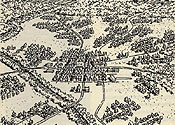How Smart Growth Happens
A number of factors, or components, of decision-making and investment are brought together to make the goals of smart growth possible.
“If you don’t know where you’re going, you might end up someplace else.” – Casey Stengel
Visioning helps assess the needs and desires of a community and planning allows those communities to bring those desires to fruition by deliberately formulating their futures.
Visioning is a process that focuses a community on where it wants to be 5, 10, 20, or 30 years down the road. It is a process in which community residents ask themselves questions such as, what
would an ideal community look like? What do I like and dislike about my community? What would make me want to leave my community? What would make me want to stay? These questions help focus a community’s vision and desires, which in turn lead to proactive planning.
Active community participation in this process is key. Bringing people together, including business, industry, and education, along with children, planners, civic leaders, environmental groups and community associations, allows the vision to capture the values and interests of a broad constituency. Once a vision is created, the community can work towards realizing its goals in an effective and deliberate way. It is a process in which communities to ask themselves a series of questions that will help direct themselves towards the best planning process:
Where are we now?
Taking stock of a community’s existing assets – social, economic, and environmental – helps identify what the community values and what needs improvements. The more community stakeholders who get involved in this process, the better – it will help ensure a complete assessment. A community assessment will produce an identification of a community’s values, an inventory of its natural and historic resources, an evaluation of its existing infrastructure, among other things.
Where are we going?
By looking at a community’s current status, its existing trends, and the desires of its residents, the next step is to figure out where it should be going. Answering this question will help a community predict, based on current trends and activities, the direction it is headed, and allows community members to visualize their future if nothing is done to intervene.
Where do we want to be?
This question helps focus communities towards common goals laid out by a vision statement, which describes the community’s desired vision of its future and lays the foundation for an action plan.
How do we get there?
This is the planning portion of the process. Creating a community’s plan of action based on its vision statement can give a community direction for moving from vision to implementation. Achieving your community’s vision requires a variety of tools and techniques that can help you implement your plan. Many of these tools and techniques are explained in detail on the “Smart Growth Techniques” section of this website. Back to top.
Regulation
The regulation of how we use and develop our land is, at its best, designed to protect the long-term interests of the public. Differing ethics among Americans regarding land use regulation has resulted in intense conflict over the extent to which the government may control property rights for the greater good of society. Is the expectation of unfettered land use warranted? Is it proper for government to preclude development for the common good? These questions are continually grappled with in the courts. But regardless of the moral or ethical questions surrounding land use regulation, it is here to stay, and it is an incredibly powerful factor that effects where and how we grow. Back to top.
Design
It can be easy to dismiss the importance of design – the design of our buildings, streets, public plazas, and open spaces – as unimportant to the quality of our communities. But quality design is integral to the creation of healthy, sustainable, pleasant places to live. It is not purely an aesthetic luxury – good design actually encourages different types of behavior. For example, a person is considerably more likely to walk along a well-lit, tree-lined street with ample sidewalks and shop windows to look into than he/she is to walk down a dark alleyway. And from an aesthetic standpoint, design creates attractive communities that people actively want to live in, as opposed to fleeing to a new development on the sprawling outskirts of town. Successful community design often involves:
- giving the development an identifiable center and edges;
- building at a scale that encourages walking to destinations;
- offering a mix of land uses and building types;
- featuring a network of walkable streets (sidewalks, trees, shade); and
- allowing for special sites and buildings for civic purposes (library, town hall, post office).
Tools available for communities to reach consensus on the design principles include visual preference surveys, computerized photo-graphics programs, and commercially-available GIS mapping products that can help communities take the long view on how and where to manage growth. Back to top.
Public Investments and Infrastructure
Public investments and infrastructure such as roads, rail lines, sewer extensions, schools, and power lines are generally financed by federal, state, or local governments. The location of these public services has profound effects on how we develop our land. Back to top.
Tax Policy
In New Jersey, property taxes are the primary source of revenue for a municipality. This system fosters competition between towns that has dramatically impacted land development patterns; in our state, our tax system has encouraged sprawl development and contributed to the strip malls, abandoned cities, and loss of open space we lament today. Back to top.












